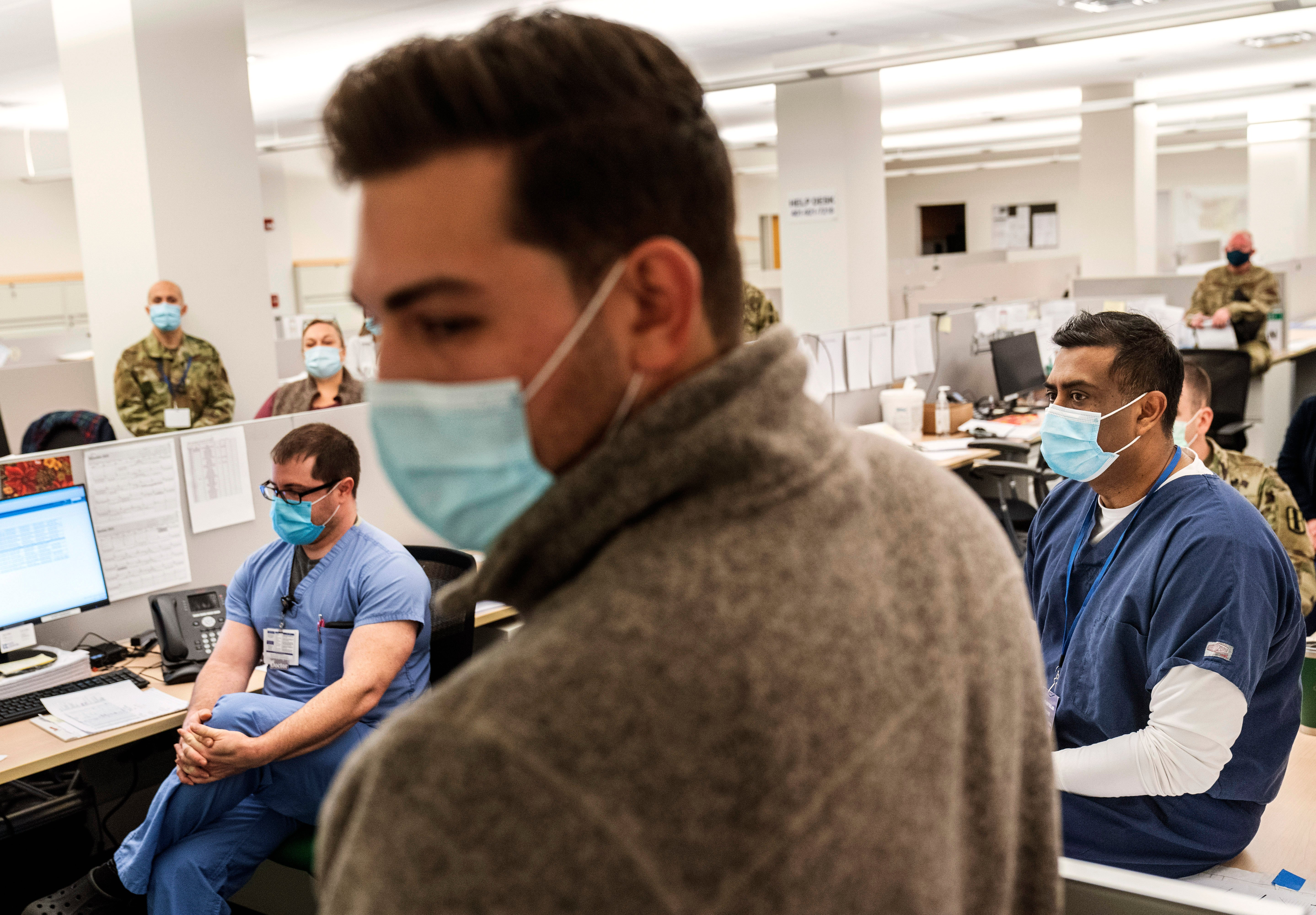AP PHOTOS: A look inside a modern COVID-19 'field hospital'
In a two-story office building on a busy commercial street, medical workers opened a COVID-19 field hospital late last November, just before Rhode Island’s infection rate became the world's highest

Your support helps us to tell the story
From reproductive rights to climate change to Big Tech, The Independent is on the ground when the story is developing. Whether it's investigating the financials of Elon Musk's pro-Trump PAC or producing our latest documentary, 'The A Word', which shines a light on the American women fighting for reproductive rights, we know how important it is to parse out the facts from the messaging.
At such a critical moment in US history, we need reporters on the ground. Your donation allows us to keep sending journalists to speak to both sides of the story.
The Independent is trusted by Americans across the entire political spectrum. And unlike many other quality news outlets, we choose not to lock Americans out of our reporting and analysis with paywalls. We believe quality journalism should be available to everyone, paid for by those who can afford it.
Your support makes all the difference.Nicholas DiPompo was finally going home.
Clutching his cane, the 78-year-old former property manager, who had spent weeks battling COVID-19 in a Rhode Island field hospital eased into a wheelchair and hollered across the hall.
“You got my number,” DiPompo shouted to fellow patient Art Singleton, whom he’d grown close to after three weeks together. “Give me a call when you get out.” He said they’d go to his favorite restaurant for baked stuffed lobster.
Singleton, 56, sat in his wheelchair and watched as a nurse pushed his friend down the makeshift hallway. Another nurse pulled DiPompo’s oxygen tank behind him, past a long row of blue curtains, a bed behind each one.
“We were at the bottom,” DiPompo said of his friendship with Singleton, a pizzeria employee who had lost part of a leg to diabetes. “He had no feet, I had heart disease.”
Then DiPompo left, wheeled out of a field hospital built in an old Citizens Bank call center, in a two-story office building on a busy commercial street. The non-profit Care New England health network opened the Kent Field Hospital on Nov. 30, just before Rhode Island’s infection rate became the highest in the world. Kent Hospital was using all its beds for its sickest COVID-19 patients, and needed somewhere for the overflow. Now, other hospitals also occasionally send patients to the field hospital.
Rhode Island’s infection rate has come down since then, and many of the field hospital’s 335 beds are now empty. On quiet days, the medical staff wishes they could do more.
Only stable, non-intubated COVID-19 patients are transferred a few miles to the field hospital, and only if they consent. Some refuse. The idea of a field hospital can conjure up images of giant tents in a war zone, canvas sides flapping in the wind.
This is nothing like that. A $6 million renovation turned the office building into a modern hospital for less-sick COVID patients, with negative-pressure air ducts that snake along the ceilings, drawing out airborne contagions.
Roughly 200 patients have gone through the field hospital, most spending just a few days before going home to finish recovering. Unlike in a regular hospital ward, where COVID patients can’t leave their rooms, patients here are free to roam.
With low patient numbers, the medical staff pays close attention to each person: Helping them walk the corridors to improve lung capacity, stretching stiff feet, handing out ice pops, coloring pictures with an elderly man, cutting Singleton's hair.
Relatives drop off fresh clothes and food, even bringing enough pizza one time for all the staff and patients. Tabletop bells, the kind once ubiquitous at hotel front desks, sit beside each bed to call for nurses.
Then there’s what the staff calls “the honeymoon suite,” the curtained-off cubicle where Peter and Pauline Sorrow are — finally, hopefully — finishing their battles with coronavirus.
Peter, 62 and Pauline, 71, have been together for 25 years. The longest they’ve been apart were the five days when Peter was first hospitalized in January for COVID-19. Since then, through recovery and relapse, he’s been in the main hospital twice, and is now finishing his second stint in the field hospital. For a few days after Pauline first got sick, they were just across the hall from one another in the main hospital, isolated in their own negative pressure rooms, communicating by phone.
Pauline, who is still mostly bedridden, was thrilled when they wheeled her bed next to Peter’s in the field hospital.
He now helps care for her: opening a stubborn lid on her lunch, cleaning a spot of food off her gown, updating their family.
“He saved me,” she said. While both are steadily recovering, Pauline worries that COVID-19 still could take both of them.
“I kind of wonder sometimes if we’re going to wake up and we won’t be here,” she said.
In many ways, the field unit’s quieter pace is a welcome relief for medical staff. Subrina Geer, 33, a nurse here on a temporary assignment, saw the disease ravage New York City last year.
This is different: “It was a breath of fresh air to see how many patients we could discharge,” she said.
Dr. Paari Gopalakrishnan, who runs the field hospital, thought by now they’d be ready to close it down. But with the main hospital still crowded with patients — many with severe COVID-19 — it’s too early for that decision.
“What we’ve basically done is kick the can down the road,” he said. The field hospital is “easy to shut off but really hard to turn it back on.”